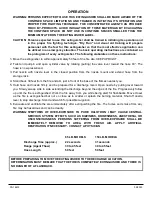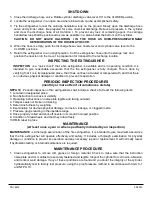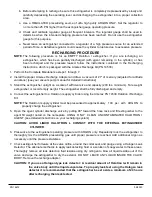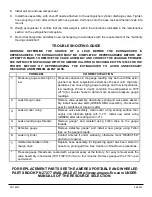
PN 16672
04/2020
COMPLETE MAINTENANCE (SIX YEAR MAINTENANCE)
Six Year Maintenance (NFPA 10) . Every 6 years, stored pressure fire extinguishers shall be emptied and
subjected to the applicable maintenance procedures. When the applicable maintenance procedures are
performed during the periodic recharging the
6
–
year requirement shall begin from that date.
WARNING
a.
Before attempting to devalve the extinguisher for maintenance, hydrotest or recharging be sure that it is
completely depressurized. Recover agent and vapor according to the instructions below.
b.
Never have any part of your body over the extinguisher while removing the valve assembly.
c.
Prolonged exposure of a devalved cylinder to ambient air shall be avoided to prevent moisture
contamination and cylinder rusting.
COMPLETE MAINTENANCE (SIX YEAR MAINTENANCE) PROCEDURES
1.
Complete items 1 through 11 in Maintenance Procedure above.
2.
Attach the appropriate recharge adapter (PN 09857) to the extinguisher operating valve on the
extinguisher cylinder. Empty the extinguisher of all pressure and Halotron l using an Amerex PN 14538
Halotron l Recharge Kit and a bulk Halotron l supply cylinder with sufficient empty capacity to accept the
contents of the extinguisher.
3.
When extinguisher is empty of all agent and pressure, remove valve assembly and disassemble by
removing downtube, spring and valve stem assembly.
Discard valve stem assembly and collar o
-
ring
.
NOTE:
Keep cylinder opening covered while devalved to minimize interior corrosion.
4.
Thoroughly clean all parts of the disassembled valve with a soft bristle brush or soft cloth. Blow the valve
out with dry nitrogen.
5.
Install a new valve stem assembly (GREEN SEAL) after lightly lubricating the valve stem o
-
ring and valve
stem seal with V
-
711. Reassemble the spring and downtube. Carefully install a new collar o
-
ring (GREEN)
which has been lightly lubricated with V
-
711. Set the valve assembly aside.
6.
Inspect the cylinder interior following CGA Visual Inspection Standard C
-
6. If a hydrotest has been
performed or any moisture is evident, the cylinder shall be immediately warm air dried.
7.
Clean the o
-
ring seating groove in the cylinder neck. If any rust is evident, remove by using a fine emery
cloth (200 grit). Clean the surface and lubricate the entire sealing area with a thin film of V
-
711. Install the
valve assembly in extinguisher cylinder. Hand tighten firmly.
8.
Complete the Recharge steps, items 2 through 11.
RECHARGE
RECHARGING (NFPA 10) is the replacement of the extinguishing agent (also includes the expellant for this
type of extinguisher).
WARNING:
a.
Halotron l service shall be performed only in a well ventilated room by a properly trained service
technician wearing proper eye protection and rubber gloves.










